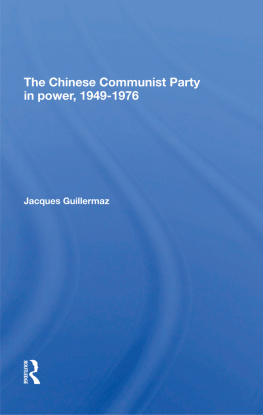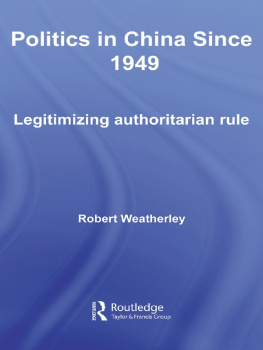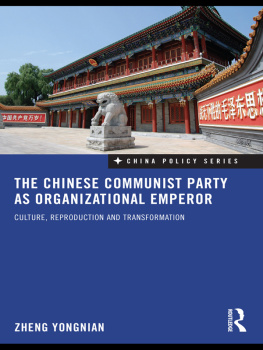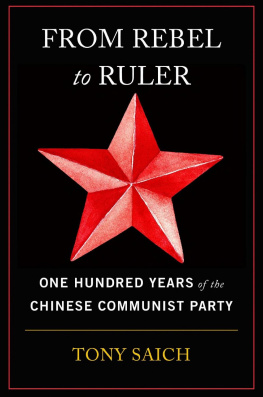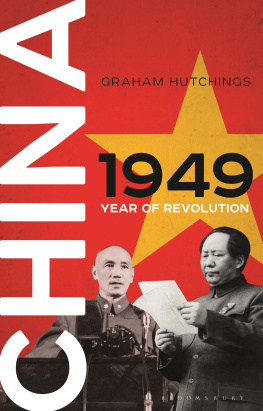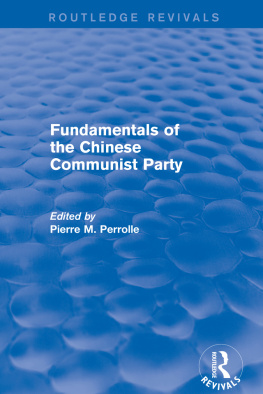Table of Contents
TO
THE END
OF REVOLUTION
TO THE
END OF
REVOLUTION
The Chinese
Communist Party
and Tibet, 19491959
XIAOYUAN LIU
Columbia University Press
New York
Columbia University Press
Publishers Since 1893
New York Chichester, West Sussex
cup.columbia.edu
Copyright 2020 Columbia University Press
All rights reserved
E-ISBN 978-0-231-55127-4
Library of Congress Cataloging-in-Publication Data
Names: Liu, Xiaoyuan, 1952 author.
Title: To the end of revolution : the Chinese Communist Party and Tibet, 19491959 / Xiaoyuan Liu.
Description: New York : Columbia University Press, [2020] | Includes bibliographical references and index.
Identifiers: LCCN 2019046848 (print) | LCCN 2019046849 (ebook) | ISBN 9780231195263 (cloth) | ISBN 9780231195270 (paperback) | ISBN 9780231551274 (ebook)
Subjects: LCSH: Tibet Autonomous Region (China)RelationsChina. | ChinaRelationsChinaTibet Autonomous Region. | CommunismChinaTibet Autonomous Region. | Tibet Autonomous Region (China)Politics and government1951
Classification: LCC DS786 .L5923 2020 (print) | LCC DS786 (ebook) | DDC 951/.5055dc23
LC record available at https://lccn.loc.gov/2019046848
LC ebook record available at https://lccn.loc.gov/2019046849
A Columbia University Press E-book.
CUP would be pleased to hear about your reading experience with this e-book at .
Cover image: Nationaal Archief/Collectie Spaarnestad/Anefo/Fotograaf onbekend/Bridgeman Images
Cover design: Lisa Hamm
CONTENTS
F or my generation, who grew up in Mao Zedongs China, two pieces of our collective memory of childhood are connected to Tibet. One is a movie made in the early 1960s, Nongnu (The Serf), about how the Chinese Communist Party (CCP) liberated Tibetan serfs from the cruel, oppressive system of the old Tibet. The other is a female Tibetan singer named Caidan Zhuoma (Tseten Dolma), who gained national fame in the 1960s and 1970s by singing songs like The Golden Mountain of Beijing and Song of Liberated Serfs. Personally, my earliest memory about Tibet dates from when I was six or seven years old. It was a horrific story related by adults about a certain means used by Tibetan feudal masters to punish their serfs. Many years later, I realized that the story was just part of the official narrative at the time. Aside from this vivid memory and its reinforcement by Nongnu, I would not encounter anything Tibetan again until I went to Inner Mongolia in the late 1960s as a zhishi qingnian (literally, intellectual youth, but historically, sent-down student). In my peoples commune in East Uzhumuqin Banner, I saw a Tibetan Buddhist temple destroyed during the Cultural Revolution. In my production brigade, I came to know a few secularized lamas, one of whom was famous for having made an arduous pilgrimage to Lhasa.
Today, Chinese youths knowledge and imagination about Tibet are neither as dark nor as sporadic as my generations. Todays young people do not sense the kind of alienness or physical and mental distance between Tibet and neidi, or the Chinese heartland, that my generation did. Though still mysterious, Tibet is now one of their favorite tourist attractions inside China, easily reachable via airlines, the famed Qinghai-Tibetan Railway, and several highways. Among young Chinese nowadays, even a bicycle ride to Lhasa from Qinghai or Sichuan or any other Chinese province does not seem such an unusual adventure. Folksongs in the Tibetan and Mongolian styles are popular in China, though many of the songs currently in circulation are not necessarily Tibetan or Mongolian by origin. For instance, an enduring contest among Chinas karaoke-goers and in talent shows on Chinese television is to see who can sing the well-nigh impossible high note of a song named Qingzang Gaoyuan (Qinghai-Tibetan Plateau). In Baidu, the Chinese alternative to Google, the song is listed as one of the best Tibetan folksongs. The song was written, however, by a Peoples Liberation Army songwriter named Zhang Qianyi, an ethnic Korean, and it was first sung by the famed female singer Li Na, an ethnic Han. Nevertheless, from Tseten Dolmas ode about Beijing as a gold mountain to Li Nas pastorale about the Tibetan Plateau, Chinese society has gone through a mental reversal about Tibet as tremendous as that of Tibetan society itself through its physical integration with the Peoples Republic of China (PRC).
These easily observable and seemingly superficial changes are actually complicated and profound. The question of what happened to cause these changes does not have simple answers. Today, a visitor in Lhasa cannot help but carry away an eerie feeling. In Lhasas streets and around monasteries, the presence of the Chinese Communist authorities is highly visible in the black or camouflage uniforms of the Tejing (special police) and the Wujing (military police). It is not unusual for a local resident to be stopped by the police several times a day for an identification check. Meanwhile, residents of Lhasa and pilgrims from other places calmly carry out their daily activities, seemingly oblivious to this heavy presence of security forces. Local tour guides may talk about the fourteenth Dalai Lama as if he had never departed from the Norbulingka in the fateful month of March 1959. One does not have to witness a self-immolation or remember the riots of 2008 to sense the tensions of the place. Globalization has indeed reached Tibet since Chinas opening to the world in the 1980s, but the CCP authorities on-again, off-again restrictions on foreign visitors have kept Tibet a frontier region that remains largely sealed, with international borders from the outside and provincial boundaries from the inside. Why has Tibet become so much closer to the rest of China but remained, like Xinjiang, a jarring problem in the eyes of the PRC authorities? This book is about how, sixty years ago, Chinese Communist leaders made a Tibetan question that they inherited from history into a Tibetan problem of their own.
More than any previous occasion, the publication of this book affords me an opportunity to acknowledge, with heartfelt gratitude, the assistance and encouragement I have received during the many years spent researching and writing it. From the outset, I knew that a book project about Beijings Tibet policy of the Mao years would be an undertaking much more challenging than any of my previous projects. However, I did not expect a long interruption of my work by circumstances beyond my control. A special group of people must therefore be acknowledged for helping me overcome a tremendous hurdle in my personal as well as professional life. Their care, support, and counsel were physically healing, spiritually uplifting, and intellectually stimulating, and without them I would not have been able to present this book to its readers. These people include my mentors, friends, colleagues, and physicians who, each in her/his own way, enabled the completion of this study. I am blessed to have them in my life: Warren Cohen, Larry and Mariam Gelfand, Akira Iriye, William Kirby, Steven Levine, Rod MacFarquhar, Peter Perdue, Qi Shirong, and Ezra Vogel; Uradyn E. Bulag, Bi Aonan, Chen Jian, Hamilton Cravens, Dai Chaowu, Charles Dobbs, Fan Xin, He Yan, Gan Qi, Ge Hao, Guo Jianping, Han Gang, Hao Rui, Bob Hathaway, Carma Hinton, Huang Haoru and Zhu Rongjun, Jiang Huajie, Angela Kao, Sulmaan Khan, Li Danhui, Li Suwu, Li Xiaobing, Hsiao-ting Lin, Liu Yuan, Mao Sheng, James Millward, Aili Mu and Ren Yue, Niu Jun, Christian Ostermann, Qian Xiaohua, Sergey Radchenko, Pamela Rinay-Kehrberg, Patrick F. Shan, Shao Fangchen, Shen Zhihua, Richard J. Smith, Sun Baowen, Tian Xiansheng, Alan M. Wachman, Wang Haiguang, Wang Jinping, Wang Xi, Wang Zheng, George C. X. Wei, David Wilson, Xiao Xiaohong, Xie Jun, Xu Guoqi, Xu Lan, Yang Kuisong, Yang Zhiguo, Yao Baihui, Yao Ping, Yao Yu and Guo Youxin, Min-lei Ye, Ye Xiangdong and Li Shuxian, Yu Jiandong, Yu Kwok-leung, Yu Qun, Zhang Baijia, Ellen Zhang, Zhang Xiaojun, Zhang Yang, Zhang Yijun, and Zhou Na; and Dr. Peter Enzinger, Dr. Ahmad Fotovat, Dr. Larry Otteman, and Dr. Lansheng Wang.





